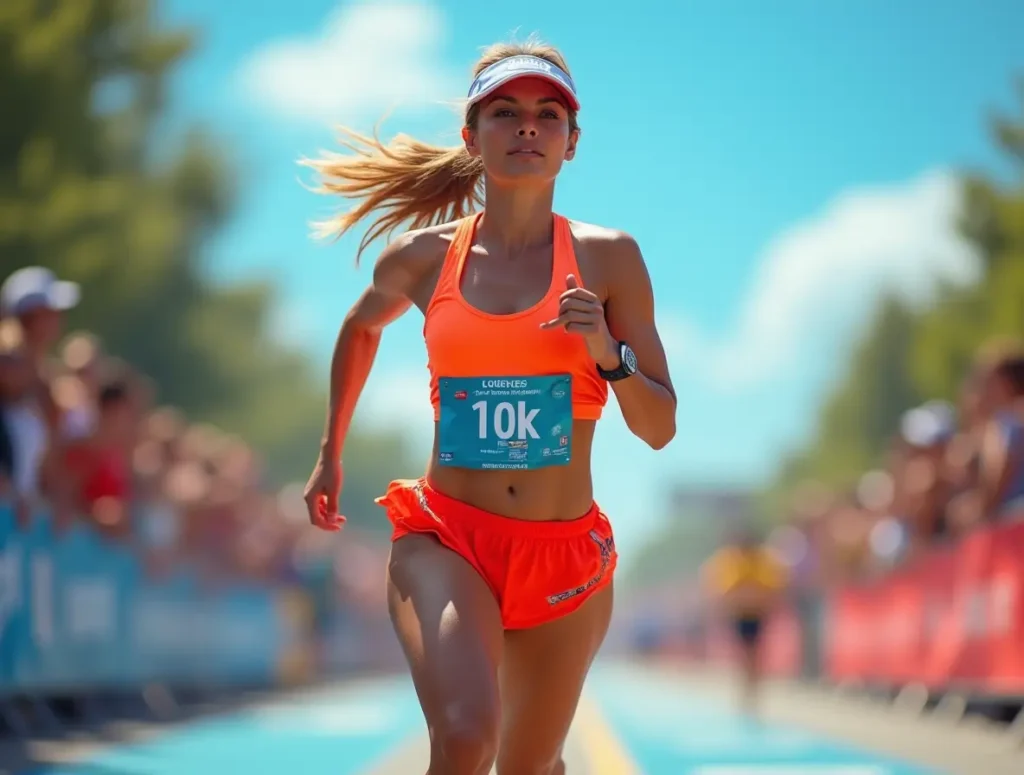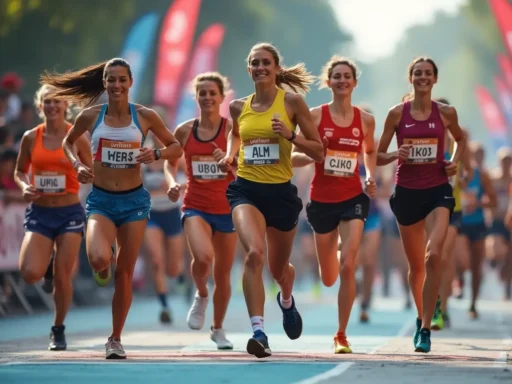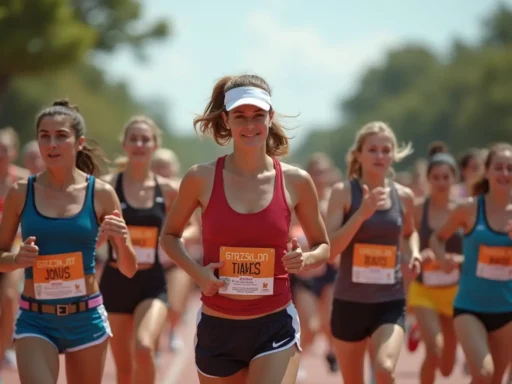Are you getting ready for a running challenge? You might wonder, how far is a 10K run? It’s about 6.2 miles, which can seem tough for beginners. Knowing the distance in both kilometers and miles helps you set goals and prepare for your 10K run. Understanding how far is a 10K run will significantly enhance your training experience.

Whether you’re experienced or new to running, knowing how far is 10K run is key. It helps you plan your training and pace on race day. In this article, we’ll cover how far how far is 10k run and kilometers, emphasizing the importance of knowing how far is 10K run for effective preparation. We’ll give you the info you need to tackle your next 10K run confidently.
Table of Contents
Understanding how far is a 10K run and its significance
To figure out how far is 10K run, we need to know the basics. A 10K run is 10 kilometers or 6.2 miles long. It’s twice as long as a 5K race, making it a big challenge for runners. Understanding how far is 10K run can help you prepare better for your training and boost your confidence in completing the distance.
Knowing how far is 10K run allows you to set realistic training goals and track your progress effectively throughout your training journey.
Converting kilometers to miles is easy: 1 kilometer is about 0.621371 miles. So, a 10K run is roughly 6.21371 miles. Running a 10K is like circling a baseball diamond many times. The exact number of laps depends on the diamond’s size, but it gives you an idea of the distance.
Familiarizing yourself with how far is 10K run will help you manage your pacing and hydration strategies on race day.
When planning your training, it’s important to know exactly how far is 10K run to set realistic goals. This understanding will guide your training plan and prepare you for race day.
Understanding how far is 10K run can also motivate you to push through your training, reminding you of the finish line and the accomplishment that awaits you.
The distance of a 10K run is crucial for developing a well-rounded training program tailored to your personal fitness level.
Once you grasp how far is 10K run, you can better appreciate the challenge it presents. Acknowledging this distance will empower you during your training.
Being aware of how far is 10K run helps when you are pacing yourself during the race, ensuring that you distribute your energy wisely.
Breaking Down the Numbers
A 10K run is a big distance. Runners usually train for weeks to get ready. Beginners might need 12 weeks, while more experienced runners might need 6-10 weeks. The goal is to slowly increase your running distance and intensity to avoid injuries and build endurance.
Visual Distance Comparisons
Visualizing the distance can help you understand a 10K run better. For example, running 10 kilometers is like running 25 laps on a 400-meter track. Or, it’s like running from one end of a town to the other, depending on the town’s size. These comparisons can make the distance feel more manageable.
Many runners ask, ‘how far is a 10K run?’ as they prepare for their first race, highlighting the distance’s significance in their training.
If you’re planning to run a 10K, understanding how far is a 10K run is essential for your training plan. This knowledge will help you feel prepared and confident on race day.
| Distance | Kilometers | Miles |
|---|---|---|
| 5K | 5 | 3.1 |
| 10K | 10 | 6.2 |
| Half Marathon | 21.1 | 13.1 |
Knowing the basics of a 10K run is key for any runner aiming to tackle this challenge. By understanding how far a 10K is and how to prepare, you can set yourself up for success and reach your running goals.
The History and Significance of the 10K Distance
Knowing how far is a 10K run makes it easier to break down your training into manageable segments.
As you train, continually remind yourself of how far is a 10K run to keep your goals in sight.
With each long run, remember that you’re preparing to conquer how far is a 10K run.
The 10K run has a rich history, starting in the late 19th century. The first 10K race was in 1897, in Prague, called the Běchovice–Prague race. Since then, it has become a favorite among runners of all levels. It’s known for boosting physical fitness and helping raise funds for good causes.
Today, the 10K run is a key part of the running world. Many big cities hold 10K races every year. These races are often charity events, helping to improve health and raise money for different causes. The 10k run history is filled with amazing achievements, like world records by top runners like Rhonex Kipruto and Agnes Ngetich.
Some famous 10K races include:
How far is a 10K run? It’s a distance that many runners aspire to conquer.
- The Peachtree Road Race in Atlanta, which hosts nearly 57,000 runners each year
- The Vancouver Sun Run and Bolder Boulder, which both have close to 50,000 runners
- The World’s Best 10K, which offers a total prize purse of over $100,000
| Event | Location | Number of Runners |
|---|---|---|
| Peachtree Road Race | Atlanta | 57,000 |
| Vancouver Sun Run | Vancouver | 50,000 |
| Bolder Boulder | Boulder | 50,000 |
How Far is a 10K Run in Common Terms
Understanding how far is a 10K run will help you not only with your running strategy but also with mental preparation as you approach race day.
To grasp the 10K run distance, it’s useful to compare it to familiar measures. A 10K run is about 6.2 miles long. This is the same as running 91 football fields, including both end zones. This comparison helps you visualize the distance and get ready for your run.
A 10K run is a big distance in everyday terms. The average person walks 3-4 miles a day. So, a 10K run is about 1.5 to 2 times the distance of a typical day’s walking. Knowing the 10K run distance in miles helps you plan your training and set achievable goals.
Understanding the 10K run distance and visualizing the course can help you prepare for your run. Knowing how far is 10k run and what to expect from the course can boost your confidence and improve your performance significantly.
Here are some examples of everyday distance equivalents to help you understand the 10K run distance:
- Running around a football field (including both end zones) 91 times
- Walking from one end of a large city to the other (approximately 6-8 miles)
- Jogging around a park or trail system multiple times
Popular 10K Race Routes
Many popular 10K race routes are scenic and challenging. Some examples include:
| Route | Location | Description |
|---|---|---|
| Beachfront 10K | Coastal cities | A scenic run along the beach with ocean views |
| Park Loop 10K | Urban parks | A challenging run through hilly park terrain |
| City Streets 10K | Major cities | A fast and flat run through city streets |
Knowing how far is a 10K run can help you plan your nutrition and hydration on race day, aligning your fueling strategy with the distance.
Your training and preparation hinge on understanding how far is a 10K run, allowing for a tailored approach to your workouts.
Also, knowing how far is 10K run can help you gauge your progress in training, providing a clear metric to track your improvements.
Understanding the 10K run distance and visualizing the course can help you prepare for your run. Knowing how far is 10k run and what to expect from the course can boost your confidence and improve your performance.
Physical Demands of a 10K Run
Getting ready for a 10K run means knowing what it takes. You need good heart health and endurance. So, start by increasing your running distance each week, but don’t go too fast to avoid injuries.
Good food and water are key to help your body recover. They are important for your training success.
Running a 10K is tough, but with the right plan, you can get better. Add long runs, intervals, and tempo runs to your routine. Also, make sure to rest every 3 to 4 weeks. This lets your body recover and get stronger.
Here are some tips for training:
- Begin with shorter runs and slowly add more miles each week.
- Do strength exercises to make your running better.
- Eat right and drink plenty of water to support your training.
- Listen to your body and take rest days when needed.
Follow these tips and understand the demands of a 10K run. Stay consistent, listen to your body, and believe in yourself. With hard work, you can succeed in your 10K run.
Average Time to Complete a 10K Run
The time it takes to finish a 10K run varies. It depends on your fitness, running experience, and age. A fit runner usually takes 50 to 70 minutes. More skilled runners finish in 43 to 50 minutes. The fastest can run a mile in 7 minutes.
The average time for a 10K is about 49:43 for all ages and genders. But, times can change based on who you are. For example, men usually finish in 55:37, while women finish in 1:03:17. These are just averages to help you set your own goals.
Beginner Finish Times
Beginners find a 10K challenging but rewarding. They can take from 1:05:30 to over 1:30:00 to finish. A brisk walker might take 1:30:00, while a beginner runner might take 1:05:30 to 1:10:00.
Intermediate Runner Times
Intermediate runners finish faster. With regular training, they can run a 10K in 46:43 to 55:48. They can get even faster with more practice and training.
Elite Runner Standards
Elite runners are very fast. The fastest 10K time is 26:24 by Rhonex Kipruto in 2020. The fastest woman’s time is 28:46 by Agnes Ngetich in 2024. These times show how fast elite runners are.
To run a 10K faster, focus on training, pacing, and nutrition. Know your fitness level and set goals. Whether you’re new or experienced, tracking your progress and staying motivated are key to success.
Training Requirements for a 10K
Ultimately, knowing how far is a 10K run will empower you to achieve your personal best.
Consistency is crucial for 10k run training. You need a structured plan with different types of workouts. This mix helps you get ready for the 10K challenge.
A typical 10k run training plan lasts 8 to 10 weeks. Beginners should start with shorter runs and increase the distance by 10-15% each week. More experienced runners can aim for a 4-6 week plan, focusing on speed and endurance.
Here are some general guidelines for 10k run training:
- Start with 3-4 runs per week, with one longer run on the weekends
- Incorporate strength training and cross-training to improve overall fitness and reduce the risk of injury
- Gradually increase your weekly mileage by 10-15% each week
- Include rest and recovery days to allow your body to repair and adapt
By sticking to a well-structured 10k run training plan and meeting the 10k run requirements, you’ll be ready for a successful 10K run.
| Training Plan | Duration | Weekly Mileage |
|---|---|---|
| Beginner | 8-10 weeks | 10-20 miles |
| Intermediate | 4-6 weeks | 20-30 miles |
| Advanced | 2-4 weeks | 30-40 miles |
As you reflect on your training journey, think about how far is a 10K run.
Essential Gear for 10K Running
Getting ready for a 10K run means having the right gear. It helps with training and keeps you injury-free. The right 10k run gear is key for a good and comfy run. There are a few must-haves for your 10k run essentials.

Your gear list should include good running shoes, clothes, and ways to stay hydrated. Proper running shoes give your feet the support and cushioning they need. Make sure to wear your new shoes for at least 12 runs before the race. Also, moisture-wicking clothing keeps you dry and comfy.
Key Gear Items
- Proper running shoes
- Moisture-wicking clothing
- Hydration equipment, such as a water bottle
- Race bib and safety pins or magnets
- Running watch or fitness tracker
Having the right 10k run essentials can greatly improve your performance and experience. Quality gear ensures a comfortable and successful run. Choose gear that fits your needs and preferences. If needed, ask for advice from running experts or specialty stores.
Building Your 10K Running Schedule
Creating a 10k run schedule means setting realistic goals and finding a training plan that fits you. It’s important to be consistent and patient when training for a 10K. Your plan should include running, cross-training, and rest days to help your body recover.
A typical 10K training plan lasts 8 weeks. The first three weeks focus on building your fitness and avoiding injuries. As you get better, you can add more intense workouts and longer runs to your schedule. Always listen to your body and adjust your plan as needed.
Here are some tips to help you build your 10K running schedule:
- Start with a base running distance of at least 2 miles or about 20 to 30 minutes
- Incorporate rest days on Mondays and Fridays to aid recovery
- Include cross-training sessions on Wednesdays for 30 to 40 minutes at an easy to moderate effort
- Gradually increase your long run distance on Saturdays, from 2 miles to 7 miles over the course of the training plan
Remember to stay hydrated, eat a balanced diet, and get enough sleep. With a good 10k run schedule and consistent training, you’ll reach your 10K goal in no time.
| Week | Monday | Tuesday | Wednesday | Thursday | Friday | Saturday | Sunday |
|---|---|---|---|---|---|---|---|
| 1 | Rest | 3 miles run | Cross-training | 2 miles run | Rest | 4 miles long run | 2 miles easy run |
| 2 | Rest | 3.5 miles run | Cross-training | 2.5 miles run | Rest | 5 miles long run | 2.5 miles easy run |
| 3 | Rest | 4 miles run | Cross-training | 3 miles run | Rest | 6 miles long run | 3 miles easy run |
Nutrition Strategies for 10K Success
As you get ready for your 10K run, good nutrition is key. A balanced diet will boost your performance and help you reach your goals. It’s important to fuel your body with the right foods for your 10K run.
Your diet should have a mix of carbs, protein, and fat. Aim for 45-55% carbs, 15-20% protein, and 25-35% fat. For example, a 75 kg runner might need 375 grams of carbs, 90 grams of protein, and 112.5 grams of fat daily.

Pre-Run Fuel
Eat a meal high in carbs, moderate in protein, and low in fat before the race. This meal should be eaten 2-3 hours before. Good options include oatmeal with fruit, whole-grain toast with avocado, or a smoothie bowl with banana and almond milk.
Also, have a snack 30-60 minutes before the race. Choose something like an energy bar, fruit, or energy chews.
Post-Run Recovery
After your run, refuel with carbs and protein to recover. Aim for 20-25 grams of protein and 30-60 grams of carbs within 30-60 minutes. Good recovery foods are chocolate milk, recovery shakes, or a turkey sandwich on whole-grain bread.
Don’t forget to drink water and electrolyte-rich drinks before, during, and after your run. With the right nutrition plan, you’ll perform better, support your training, and reach your goals.
Common Challenges in 10K Running
Training for a 10K run can face you with many 10k run challenges. These can be physical, mental, or both. Common 10k run obstacles include lack of motivation, not enough training, and bad nutrition.
To beat these challenges, create a solid training plan. It should mix running, cross-training, and rest days. Also, eating right and staying hydrated can boost your performance and lower injury risks.
Here are some tips to tackle 10k run challenges:
- Set achievable goals and track your progress.
- Find a running buddy or join a group for motivation and support.
- Add strength training and cross-training to boost fitness and prevent injuries.
By tackling these 10k run obstacles, you can up your chances of success. You’ll reach your 10K run goals.
Mental Preparation for Your 10K
Getting ready for your 10K run means focusing on your mental game. It’s about setting goals and making a race plan that fits you. Studies show that mental prep is key for 10K success. A positive mindset can greatly improve your performance.
To begin, set specific and achievable goals for your 10K. Break down your goal into smaller tasks, like increasing your weekly runs or adding strength training. This keeps you focused and motivated. Also, visualize your success by imagining crossing the finish line. This boosts your confidence and prepares you for race challenges.
Developing a Race Day Strategy
On race day, having a solid plan is crucial. Make sure to stay hydrated by drinking water all day before the race. Also, fuel your body with a balanced meal or snack. Start slow and gradually pick up speed as you warm up. This saves energy and prevents burnout.
Here are more tips for mental prep for your 10K:
- Get plenty of rest and sleep before the race
- Stay positive and focused on your goals
- Use positive self-talk to motivate yourself
- Visualize yourself succeeding and overcoming challenges
By following these tips and building a strong 10k mindset, you’ll be ready to conquer your 10K. Stay focused, motivated, and positive. You’ll be crossing that finish line in no time.
| Distance | Time | Pace |
|---|---|---|
| 10K | 60-75 minutes | 10-minute mile |
| 5K | 31 minutes | 10-minute mile |
| Half Marathon | 2 hours 37 minutes | 12-minute mile |
Health Benefits of Training for a 10K
Training for a 10K run offers many 10k run health benefits. These include better heart health and more endurance. Running regularly can also lower the risk of serious diseases like heart disease and diabetes. Plus, it can help your mental health by reducing stress and anxiety.
Some of the key 10k run health benefits include:
- Improved cardiovascular health
- Increased endurance
- Weight management
- Improved mental health
To get these 10k run fitness benefits, make running a regular part of your routine. Start with short runs and slowly increase the distance to avoid injuries. Always drink plenty of water and eat a balanced diet to fuel your body.
| Benefit | Description |
|---|---|
| Cardiovascular Health | Improved heart health and reduced risk of chronic diseases |
| Increased Endurance | Improved ability to perform daily tasks and activities |
| Weight Management | Assistance with weight loss and maintenance |
| Improved Mental Health | Reduced stress and anxiety, improved mood |
Recovery Tips After Your 10K Run
After a 10K run, it’s key to focus on 10k run recovery. This helps your body heal and rebuild. A good 10k run post-run care plan can boost your performance and lower injury risks.
A good recovery plan includes rest, hydration, and nutrition. Listen to your body and let it recover at its own pace. This might mean taking a few days off or doing low-intensity workouts to aid healing.
Here are some recovery tips after your 10K run:
- Stay hydrated by drinking plenty of water and electrolyte-rich fluids
- Consume a balanced meal with protein, complex carbohydrates, and healthy fats within 30-60 minutes after your run
- Incorporate stretching and foam rolling to help reduce muscle soreness and improve flexibility
- Get enough sleep and aim for 7-9 hours of rest each night
By following these tips and focusing on 10k run recovery, you can recover from running a 10K. This way, you’ll be ready for your next challenge. Remember, 10k run post-run care is also crucial for a full recovery.
| Recovery Tip | Benefits |
|---|---|
| Stay hydrated | Helps replenish lost fluids and electrolytes |
| Consume a balanced meal | Provides essential nutrients for muscle recovery and repair |
| Incorporate stretching and foam rolling | Helps reduce muscle soreness and improve flexibility |
Tracking Your 10K Progress
Starting your 10K journey means tracking your 10k run progress. Use a running log or app to record your runs. This includes distance, time, and pace. It helps you see patterns, set goals, and adjust your training.
Focus on progress, not perfection, when tracking your 10k run tracking. Seeing your progress helps you make smart training choices. For instance, track your mileage, pace, and heart rate to fine-tune your plan.
Here are some tips to start tracking your 10k run progress:
Remember, how far is 10K run is not just a question; it’s a goal for many.
- Set realistic goals, like running a certain number of times a week or reaching a pace goal
- Use a running log or app to track your runs, including distance, time, and pace
- Monitor your progress and adjust your training plan as needed
By following these tips and tracking your 10k run progress, you’ll stay motivated and see improvement. Remember to stay consistent, listen to your body, and enjoy the journey. You’ll be on your way to a successful 10k run tracking journey.
| Week | Distance | Pace | Progress |
|---|---|---|---|
| 1 | 3 miles | 10 minutes/mile | Completed first run |
| 2 | 4 miles | 9.5 minutes/mile | Increased distance by 1 mile |
| 3 | 5 miles | 9 minutes/mile | Improved pace by 0.5 minutes/mile |
Popular 10K Events Around the United States
Are you getting ready for a 10k run? You might want to join a popular 10k run event in the United States. These events let you run with others, feel the excitement of a big race, and aim for your best time.
The New York City 10K and the Chicago 10K are well-known. They draw thousands of runners. You’ll enjoy scenic routes and lots of cheers. Many cities and towns also host 10k races, often as part of a bigger festival or charity event.
Major City Races
Major city races offer a thrilling experience. You’ll run past famous landmarks and hear cheers from the crowd. Some top races include:
- New York City 10K
- Chicago 10K
- Los Angeles 10K
Seasonal Running Events
There are also seasonal running events all year. These have a fun, festive vibe with themed costumes and celebrations. Some seasonal events are:
| Event | Location | Time of Year |
|---|---|---|
| Thanksgiving Day 10K | Various locations | November |
| Christmas Lights 10K | Various locations | December |
| New Year’s Day 10K | Various locations | January |
Whether you’re an experienced runner or new to the sport, joining a 10k event is rewarding. With so many options, you’ll find one that matches your interests and schedule.
Conclusion
The 10K run is a tough but rewarding challenge. It’s great for your fitness and well-being. Whether you’re new to running or a seasoned pro, the 10K is a chance to reach your goals and celebrate your success.
You now know how important the 10K distance is. You’ve learned about its history and the physical and mental challenges it poses. With good training, the right gear, and smart nutrition and recovery, you can beat the 10K and feel proud of yourself.
The 10K run is more than just the finish time. It’s about finding yourself, the support of the running community, and growing as a person. Stay motivated, listen to your body, and face the challenges of training and running a 10K. The rewards are worth it.
So, what are you waiting for? Put on your running shoes, make a training plan, and start your 10K adventure today. With hard work and determination, you’ll soon be crossing that finish line. You’ll also learn to appreciate the strength of the 10K distance.




